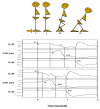A water-based training program that include perturbation exercises to improve stepping responses in older adults: study protocol for a randomized controlled cross-over trial
- PMID: 18706103
- PMCID: PMC2532994
- DOI: 10.1186/1471-2318-8-19
A water-based training program that include perturbation exercises to improve stepping responses in older adults: study protocol for a randomized controlled cross-over trial
Abstract
Background: Gait and balance impairments may increase the risk of falls, the leading cause of accidental death in the elderly population. Fall-related injuries constitute a serious public health problem associated with high costs for society as well as human suffering. A rapid step is the most important protective postural strategy, acting to recover equilibrium and prevent a fall from initiating. It can arise from large perturbations, but also frequently as a consequence of volitional movements. We propose to use a novel water-based training program which includes specific perturbation exercises that will target the stepping responses that could potentially have a profound effect in reducing risk of falling. We describe the water-based balance training program and a study protocol to evaluate its efficacy (Trial registration number #NCT00708136).
Methods/design: The proposed water-based training program involves use of unpredictable, multi-directional perturbations in a group setting to evoke compensatory and volitional stepping responses. Perturbations are made by pushing slightly the subjects and by water turbulence, in 24 training sessions conducted over 12 weeks. Concurrent cognitive tasks during movement tasks are included. Principles of physical training and exercise including awareness, continuity, motivation, overload, periodicity, progression and specificity were used in the development of this novel program. Specific goals are to increase the speed of stepping responses and improve the postural control mechanism and physical functioning. A prospective, randomized, cross-over trial with concealed allocation, assessor blinding and intention-to-treat analysis will be performed to evaluate the efficacy of the water-based training program. A total of 36 community-dwelling adults (age 65-88) with no recent history of instability or falling will be assigned to either the perturbation-based training or a control group (no training). Voluntary step reaction times and postural stability using stabiliogram diffusion analysis will be tested before and after the 12 weeks of training.
Discussion: This study will determine whether a water-based balance training program that includes perturbation exercises, in a group setting, can improve speed of voluntary stepping responses and improve balance control. Results will help guide the development of more cost-effective interventions that can prevent the occurrence of falls in the elderly.
Figures





Similar articles
-
A perturbation-based balance training program for older adults: study protocol for a randomised controlled trial.BMC Geriatr. 2007 May 31;7:12. doi: 10.1186/1471-2318-7-12. BMC Geriatr. 2007. PMID: 17540020 Free PMC article. Clinical Trial.
-
Effect of a perturbation-based balance training program on compensatory stepping and grasping reactions in older adults: a randomized controlled trial.Phys Ther. 2010 Apr;90(4):476-91. doi: 10.2522/ptj.20090070. Epub 2010 Feb 18. Phys Ther. 2010. PMID: 20167644 Clinical Trial.
-
Perturbation-based gait training to improve daily life gait stability in older adults at risk of falling: protocol for the REACT randomized controlled trial.BMC Geriatr. 2020 May 7;20(1):167. doi: 10.1186/s12877-020-01566-z. BMC Geriatr. 2020. PMID: 32380950 Free PMC article. Clinical Trial.
-
Exercise for preventing falls in older people living in the community.Cochrane Database Syst Rev. 2019 Jan 31;1(1):CD012424. doi: 10.1002/14651858.CD012424.pub2. Cochrane Database Syst Rev. 2019. PMID: 30703272 Free PMC article.
-
Methods to assess and improve the physical parameters associated with fall risk in older adults.Prev Med. 2003 Mar;36(3):255-64. doi: 10.1016/s0091-7435(02)00028-2. Prev Med. 2003. PMID: 12634016 Review.
Cited by
-
Influence of spinal sagittal alignment, body balance, muscle strength, and physical ability on falling of middle-aged and elderly males.Eur Spine J. 2013 Jun;22(6):1346-53. doi: 10.1007/s00586-013-2721-9. Epub 2013 Feb 27. Eur Spine J. 2013. PMID: 23443680 Free PMC article.
-
Does aquatic exercise improve commonly reported predisposing risk factors to falls within the elderly? A systematic review.BMC Geriatr. 2019 Feb 22;19(1):52. doi: 10.1186/s12877-019-1065-7. BMC Geriatr. 2019. PMID: 30795740 Free PMC article.
-
Perturbation-based Balance Training in Adults Aged Above 55 Years with Chronic Low Back Pain: A Comparison of Effects of Water versus Land Medium - A Preliminary Randomized Trial.Curr Aging Sci. 2024;17(2):156-168. doi: 10.2174/0118746098254991231125143735. Curr Aging Sci. 2024. PMID: 38111118 Clinical Trial.
-
Balance as an Additional Effect of Strength and Flexibility Aquatic Training in Sedentary Lifestyle Elderly Women.Curr Gerontol Geriatr Res. 2020 Jan 25;2020:1895473. doi: 10.1155/2020/1895473. eCollection 2020. Curr Gerontol Geriatr Res. 2020. PMID: 32411217 Free PMC article.
-
Falls in Geriatric Populations and Hydrotherapy as an Intervention: A Brief Review.Geriatrics (Basel). 2018 Oct 18;3(4):71. doi: 10.3390/geriatrics3040071. Geriatrics (Basel). 2018. PMID: 31011106 Free PMC article. Review.
References
-
- Tinetti ME, Speechley M, Ginter SF. Risk factors for falls among elderly persons living in the community. N Engl J Med. 1988;319:1701–1707. - PubMed

